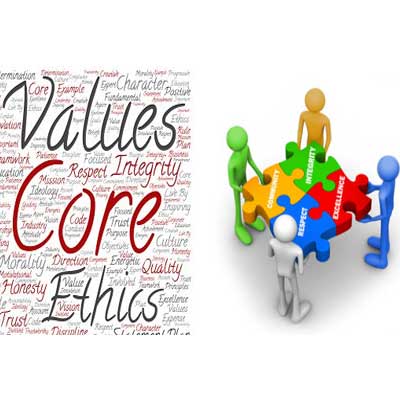Values and Ethics – Mere Compliance or Vital For Achieving Business Objectives? | Aparna Sharma | Consulting Editor | The People Management
 Values are the basic and fundamental beliefs that guide or motivate attitudes or actions. Organizations define Core Values such as Integrity, Commitment, Excellence, Passion, Courage, Responsibility, Quality, Agility, Collaboration, Diversity etc.
Values are the basic and fundamental beliefs that guide or motivate attitudes or actions. Organizations define Core Values such as Integrity, Commitment, Excellence, Passion, Courage, Responsibility, Quality, Agility, Collaboration, Diversity etc.
The biggest question is whether these are just stated written down values or an organization would actually like to live by them.
Here are a few examples to understand the difference between stated or lived values-
- Diversity is the stated value, however the organization advertises a job vacancy stating only male candidate should apply, despite the fact that the work could be performed by a female too. This organization is not living up to the stated value of Diversity.
- An organization is not making transparent disclosure of product quality, despite fairness being the stated value.
- An organization that is consuming massive energy, heavy pollutant discharge and chemical is flown in the nearby river, claims to be socially responsible.We are all aware that compromising on values led to the collapse of large global organisations such as Enron, Worldcom, Lehman Brothers etc. The striking difference between successful and not so successful organisations is their ability to define, assimilate and monitor adherence to values & ethics by all the stakeholders. Like a human body can’t stand without bones, organizations can’t exist and succeed in the long run without Core Values.
Ethics
Corporate Ethics is a form of professional ethics that examines ethical principles and moral or ethical problems that can arise in a business environment. These ethics originate from individuals, organizational statements or from the legal system.
Organizational policies and procedures define ways of working which essentially prescribe what is acceptable and what could violate organizational ethos and fabric. Eg. Fairness in employee selection, garner business without offering any favour, transparent disclosure of conflict of interest, fairness in disclosing product benefits to customers, to name a few.
Chartered Accountants, Doctors, Lawyers, Engineers, judges etc. need to comply with the code of professional ethics in addition to business ethics defined by the organization they work for.
In addition, certain ethical principles are governed by the law of the land. Eg. The Prevention of Corruption Act, 1988, Prevention of Money Laundering Act, 2002, The Foreign Corrupt Practices Act (USA), The UK Bribery Act 2010 and many more regulations depending upon the jurisdiction and nature of the organization.
Non-adherence to ethics exposes organizations to variety of risks which has implications on their brand, reputation, financial strength, market share among others.
Organization Culture
Organization cultures are made up of core values and ethical principles defined and lived up consistently over hundreds of years, despite changes in promoters, senior management, employees etc. Once defined, they need to be embraced by everyone connected with the organization, eg. Employees, customers, vendors, service providers, senior management, directors, investors etc.
Typical challenges of failed values and ethics implementation are:
• Lack of understanding about organization values and its significance
• Compliance and ethics structure not defined
• Compliance and Ethics function buried several layers down the organization hierarchy, hence missing the impact
• Risk of ethical violation not understood
• Code of conduct and business ethics vaguely defined
• Misalignment of Business Strategy with Values & Ethics
• Compromise of core values not noticed or actions not initiated
• Lack of congruence in thoughts, words and actions
• Compromise of value & ethics for short term benefits eg. Paying bribe to garner business or tax dispute settlement
• Communication & reporting structure to the Board or Audit Committee not defined or followed.
Most sophisticated organizations with high end technologies may also not be able to prevent failures, unless employees understand values and ethics & work accordingly in line with the organizational culture.
Road to Implementation of the Value & Ethics framework
A robust governance framework is vital for driving tangible & intangible benefits. The framework has 5 components – Governance & Culture, Performance Strategy & Objective-Setting, Performance Review & Revision and Information, Communication, & Reporting.
To effectively live & implement the values & ethics, it requires the organization to clearly, consistently and concisely define their principles and values. The organization needs to demonstrate and spread awareness so that every stakeholder eg. employees, customers, contractors, third party service providers etc. clearly understand & make it part of their DNA. It must be implemented consistently across. During times of crisis, properly implemented values & ethics help companies enhance brand, reputation and eventually sustained growth.
All companies that have survived for many decades , have lived and demonstrated core values, whether it was at the time of world war, economic crisis or during current pandemic like Covid -19. Hence, organizations that met customer commitments, went beyond crisis, treated all fairly with integrity, and did not compromise on excellence and innovated business models have built reputation, improved profitability and developed even stronger brand.
It is extremely essential for companies to monitor values and ethics compliance and take corrective action, wherever required. Implementation of the framework requires leadership commitment, time, resources, culture change,willingness to absorb short term pain/losses, training, awareness, discipline and uniformity of actions.
Conclusion
Values and ethics form the basic DNA and fabric of the organization. Unless, each stakeholder is aligned and evaluated based on living these values and ethics (i.e. unwavering commitment and consistent demonstration, despite nobody noticing them), success and growth of the organization is difficult to achieve or even sustain.
It is the biggest differentiator which outweighs everything else and drives people to achieve the organization’s vision and uniquely position it for making the impact that matters.


